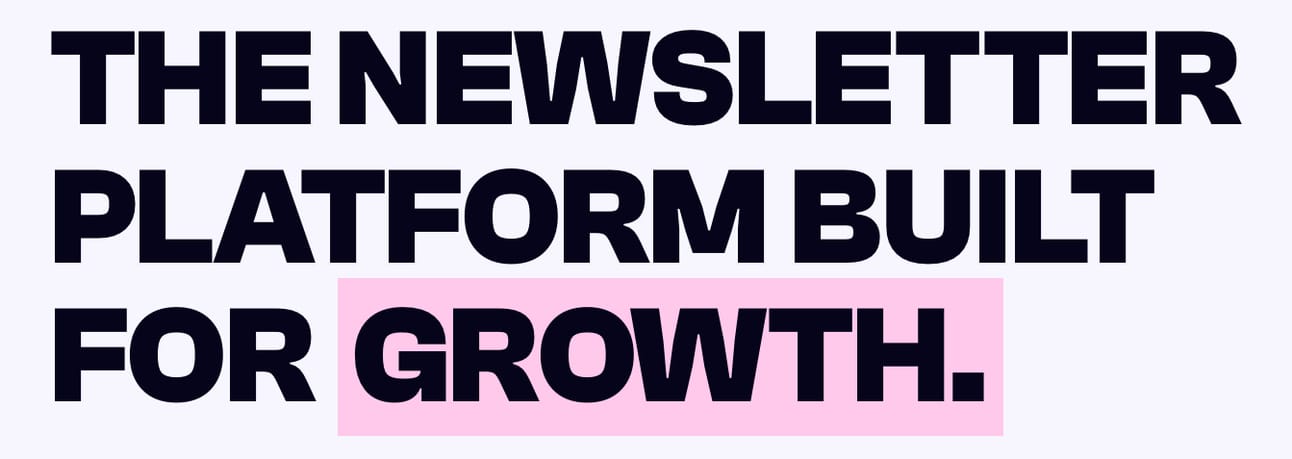Hey, Grow Newsie reader!
Let's talk about something most newsletter writers get wrong: asking for feedback.
You know you need it. Your readers have opinions. But somehow, every time you send a survey, you either get crickets or accidentally annoy half your list.
Sound familiar?
Today, I'm sharing exactly how to collect valuable reader feedback without turning your newsletter into a pushy survey machine. These are the methods that top newsletter creators use to get response rates of 15-30% (compared to the industry average of 2-5%).
Sponsored by: DESelect
2025 State of Marketing Operations Report
Stay ahead of industry shifts with the definitive 2025 State of Marketing Operations Report. This all-new edition reveals what 34 marketing ops leaders are prioritizing now: centralized audience management, AI progress, platform-agnostic strategies, and more. Don't miss the action-ready recommendations and firsthand perspectives powering high-performing teams in SaaS, retail, healthcare, and beyond. Get your copy to strategize smarter!
Before we dive into what works, let's address what doesn't:
The mistakes killing your response rates:
Sending 20-question surveys that take 10 minutes to complete
Asking for feedback at random times without context
Using corporate language that sounds like a research study
Not explaining what's in it for the reader
Bombarding subscribers with multiple survey requests
The truth? Your readers want to help you improve. They're just busy, overwhelmed, and skeptical that their input will matter.
The Golden Rule: Make It Ridiculously Easy
The best newsletter feedback comes from questions that take less than 30 seconds to answer. Period.
Here's your new framework: One question, one click, maximum impact.
For Content Quality:
"On a scale of 1-5, how useful was today's newsletter?"
Why it works: Simple rating, takes 2 seconds, gives you quantifiable data
"What's one topic you wish I'd cover more often?"
Why it works: Open-ended but specific, generates content ideas
"Which section did you find most valuable today?"
Why it works: Helps you double down on what resonates
For Understanding Your Audience:
"What's your biggest challenge with [your newsletter topic] right now?"
Why it works: Uncovers pain points you can address
"How would you describe this newsletter to a friend?"
Why it works: Gives you positioning insights and testimonial material
"What made you subscribe to this newsletter?"
Why it works: Reveals your unique value proposition
For Frequency & Format:
"Is our sending frequency too much, too little, or just right?"
Why it works: Simple multiple choice, addresses a common concern
"Would you prefer longer, in-depth issues or shorter, actionable tips?"
Why it works: Helps you optimize length without guessing
"What's your preferred time to read newsletters?"
Why it works: Optimizes send times for better open rates
For Product Development:
"If I created a paid product, what would be most valuable to you?"
Why it works: Validates monetization ideas before building
"What tools or resources would make your life easier?"
Why it works: Uncovers partnership or affiliate opportunities
For Engagement:
"On a scale of 1-10, how likely are you to recommend this newsletter?"
Why it works: This is the NPS (Net Promoter Score) question that reveals loyalty
"What's stopping you from sharing this newsletter with others?"
Why it works: Identifies barriers to organic growth
For Continuous Improvement:
"What's one thing I could do to make this newsletter even better?"
Why it works: Actionable, positive framing, shows you care
"Did I miss anything important on this topic?"
Why it works: Catches gaps in your coverage, shows humility
Non-Intrusive Feedback Methods That Feel Natural
1. The Inline Micro-Survey
Embed a single question directly in your newsletter with clickable emoji or button responses. Tools like FeedLetter or Typeform make this seamless.
Example: "Was this helpful? 👍 Yes | 👎 No | 💡 Want more"
Response rates: 10-20% (versus 2-5% for external surveys)
2. The P.S. Question
Add one casual question at the end of your newsletter in your P.S. section.
Example: "P.S. Quick question: What topic should I tackle next week? Just hit reply and let me know!"
This feels conversational, not corporate.
3. The Strategic Reply Prompt
Ask a specific question that encourages a reply, making it part of the content.
Example: "Here's what I think about AI in newsletter writing... but I'm curious: Are you using AI tools yet? Reply and tell me your experience!"
4. The Quarterly Deep Dive
Send a more comprehensive survey only 3-4 times per year, with advanced notice and a clear reason.
Example: "It's our quarterly check-in! I'm planning Q4 content and want to make sure it's exactly what you need. 5 questions, 2 minutes, huge impact on what I create for you."
5. The Segment-Specific Ask
Only survey specific segments who've shown engagement (opens, clicks, long-time subscribers).
Why it works: You're asking people who care, and they'll tell you they care.
How to Frame Your Feedback Request
The way you ask matters as much as what you ask. Use this formula:
[Context] + [Specific Ask] + [Time Estimate] + [What's In It For Them]
Example: "I'm planning next month's content (context) and want to cover what matters most to you (specific ask). One question, literally 10 seconds (time estimate). Your answer directly shapes what lands in your inbox (what's in it for them)."
When to Ask for Feedback (Timing Matters)
Best times:
After delivering exceptional value (when goodwill is high)
At natural milestones (100th issue, anniversary, 1,000 subscribers)
When making changes (new format, frequency adjustment)
Quarterly check-ins (predictable, not random)
Worst times:
In your welcome email (too soon)
After a break in publishing (fix consistency first)
Multiple times per month (survey fatigue)
When you have nothing specific to improve (asking just to ask)
What to Do With the Feedback
This is where most creators drop the ball. Collecting feedback is useless if you don't act on it.
Your action plan:
Acknowledge it: Reply to direct responses or share aggregated results
Implement changes: "Based on your feedback, I'm now..." shows you listen
Close the loop: Tell readers what changed because of their input
Track trends: Look for patterns, not one-off complaints
Example: "Last month, 67% of you said you wanted more case studies. So here's what I'm doing..."
The Survey Fatigue Prevention Checklist
Before sending any feedback request, ask yourself:
✅ Can this be answered in under 30 seconds?
✅ Is this the best time to ask (recent value delivered)?
✅ Have I waited at least 4-6 weeks since my last survey?
✅ Will I actually use this information?
✅ Have I explained why their feedback matters?
If any answer is "no," reconsider.
Tools That Make Feedback Collection Effortless
For inline surveys:
FeedLetter (simple emoji responses)
Typeform (beautiful, embedded surveys)
Tally Forms (free, unlimited responses)
For email surveys:
Google Forms (free, simple)
SurveyMonkey (robust features)
Jotform (customizable)
For NPS tracking:
Delighted
Promoter.io
Built-in features in Beehiiv, ConvertKit, or Substack
Pro tip: The simpler the tool, the higher your response rate. Stick with one-click options whenever possible.
Your Action Plan This Week
Here's how to implement this immediately:
Today: Add one inline micro-survey question to this week's newsletter
This Week: Review your last 5 issues and identify where feedback would help most
This Month: Schedule your first strategic quarterly survey
Ongoing: Create a simple system to track feedback and implement changes
The Bottom Line
Collecting reader feedback shouldn't feel like pulling teeth or annoying your subscribers. When done right, it actually increases engagement because people feel heard.
Remember: One question, one click, maximum impact.
Your readers want to help you improve. Make it easy for them, and you'll get insights that transform your newsletter from good to unmissable.
Keep growing!
With love,
Nikhil
How was today's edition?
If you’ve ever thought about starting your own newsletter (or switching to a better platform), I’ve partnered with the beehiiv team to set you up with:
✅ 20% off your first 3 months
✅ A free 30-day trial, no credit card needed


